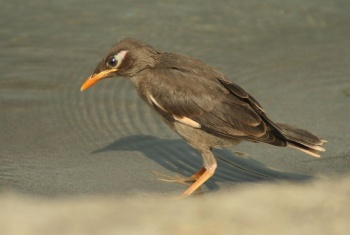(completed) |
(update link) |
||
| Line 16: | Line 16: | ||
==Taxonomy== | ==Taxonomy== | ||
[[Image:Juv BM.jpg|thumb|350px|right|Juvenile<br />Photo by {{user|vaibhav+mishra|vaibhav mishra}} <br />Kasganj, Etah, Uttar Pradesh, [[India]], June 2010]] | [[Image:Juv BM.jpg|thumb|350px|right|Juvenile<br />Photo by {{user|vaibhav+mishra|vaibhav mishra}} <br />Kasganj, Etah, Uttar Pradesh, [[India]], June 2010]] | ||
| − | This is a [[Dictionary_M- | + | This is a [[Dictionary_M-O#M|monotypic]] species. |
| + | |||
==Habitat== | ==Habitat== | ||
Cultivated areas (often near cattle) and cities. | Cultivated areas (often near cattle) and cities. | ||
Revision as of 14:33, 25 June 2014
- Acridotheres ginginianus
Identification
22cm. A smallish Myna, locally called Ganga Maina.
- Grey plumage
- Black hood and frontal crest
- Glossy black wing with buff wing-patch
- Black tail with buff outertail feathers (prominent in flight)
- Red eye with large bare orange-red cheek-patch
- Orange bill and legs
Sexes similar. Juveniles are duller and browner with paler buff markings on wings and reduced buff on tail.
Distribution
Foothills of eastern Pakistan to southern Nepal, north-central India and Bangladesh. An old record from southeast Afghanistan.
Introduced in Japan and United Arab Emirates, also reports from Kuwait, Oman and Saudi Arabia. A rare exotic in Taiwan, but no proof of breeding.
A common species in most of its range.
Taxonomy
This is a monotypic species.
Habitat
Cultivated areas (often near cattle) and cities.
Behaviour
Omnivorous. Feeds on animal food, fruit, seeds and food waste.
Forages usually in pairs or flocks.
Forms large communal roosts all year, often in sugar cane or reedbeds, also in trees or on buildings.
Breeding season mainly from April to June. A monogamous species. Excavates a tunnel in a river bank for its nest. Lays 3 - 6 eggs.
A resident species with some seasonal or nomadic movements in its range.
References
- Clements, JF. 2008. The Clements Checklist of Birds of the World. 6th ed., with updates to December 2008. Ithaca: Cornell Univ. Press. ISBN 978-0801445019.
- BF Member observations
- Del Hoyo, J, A Elliott, and D Christie, eds. 2009. Handbook of the Birds of the World. Volume 14: Bush-shrikes to Old World Sparrows. Barcelona: Lynx Edicions. ISBN 978-8496553507
Recommended Citation
- BirdForum Opus contributors. (2024) Bank Myna. In: BirdForum, the forum for wild birds and birding. Retrieved 3 May 2024 from https://www.birdforum.net/opus/Bank_Myna





